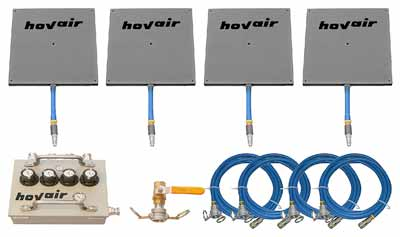Choosing the right material handling equipment is crucial for optimizing efficiency, productivity, and safety in industrial and warehouse settings. With a wide array of equipment options available, ranging from forklifts and conveyors to industrial and automobile turntables, air casters, air skates, air beams, load leveling airbags, air bearing kits, and automated systems, selecting the most suitable equipment requires careful consideration of various factors.
Need help in choosing material handling equipment that aligns with your operational needs, performance objectives, and budgetary constraints? Experts from Hovair Systems are here to help.
Call 1-800-237-4518 to schedule a consultation. But first, keep reading to find some valuable insights and practical tips to navigate the process of selecting the right material handling equipment for your facility.
Assess Operational Needs
The first step in selecting material handling equipment is to conduct a comprehensive assessment of your operational needs and requirements.
Consider factors such as the types of materials or products being handled, the volume of materials to be moved, the layout and dimensions of the facility, and any specific challenges or constraints that need to be addressed.
By understanding your operational needs upfront, you can narrow down your options and focus on equipment solutions that are best suited to your specific requirements.
Considering Facility Layout and Space Constraints
The layout and configuration of your facility play a significant role in determining the type and size of material handling equipment that can be implemented effectively.
Consider the aisle width, ceiling height, floor space, and access points when evaluating equipment options. Compact and maneuverable equipment may be preferable for confined spaces or narrow aisles, while larger equipment may be suitable for open and spacious environments.
Additionally, consider future expansion plans or changes in facility layout when selecting equipment to ensure scalability and adaptability over time.
Define Performance Metrics
Clearly define the performance metrics and key performance indicators (KPIs) that you aim to achieve with the new material handling equipment. These may include throughput rates, cycle times, accuracy levels, and safety records. By establishing clear performance objectives, you can evaluate equipment options based on their ability to meet or exceed your performance targets and drive operational excellence.
Assess Total Cost of Ownership
When evaluating material handling equipment options, consider the total cost of ownership (TCO) over the equipment’s lifespan. This includes the initial purchase price and ongoing operating costs, maintenance expenses, training requirements, and potential downtime costs. By taking a holistic view of the TCO, you can make more informed decisions and choose equipment that offers the best value and return on investment (ROI) over time.

Prioritize Safety Features
Safety should be a top priority when selecting material handling equipment, especially in industrial environments where workers risk injury or accidents. Look for equipment that is equipped with safety features such as anti-tip mechanisms, overload protection, safety guards, and ergonomic design features. Additionally, consider training requirements and ensure that operators receive proper training on equipment operation and safety protocols.
Understand Material Characteristics
Different materials have unique characteristics that influence the selection of handling equipment. Consider factors such as size, weight, shape, fragility, and hazardous properties when evaluating equipment options.
Ready to optimize your material handling operations? Schedule a consultation now so our experts can help you select the appropriate material handling equipment that maximizes productivity, ensures safety, and boosts operational efficiency.
With Hovair Systems’ ergonomic equipment moving systems, you can move heavy loads of all weights, shapes, types, and sizes safely, productively, and conveniently.
